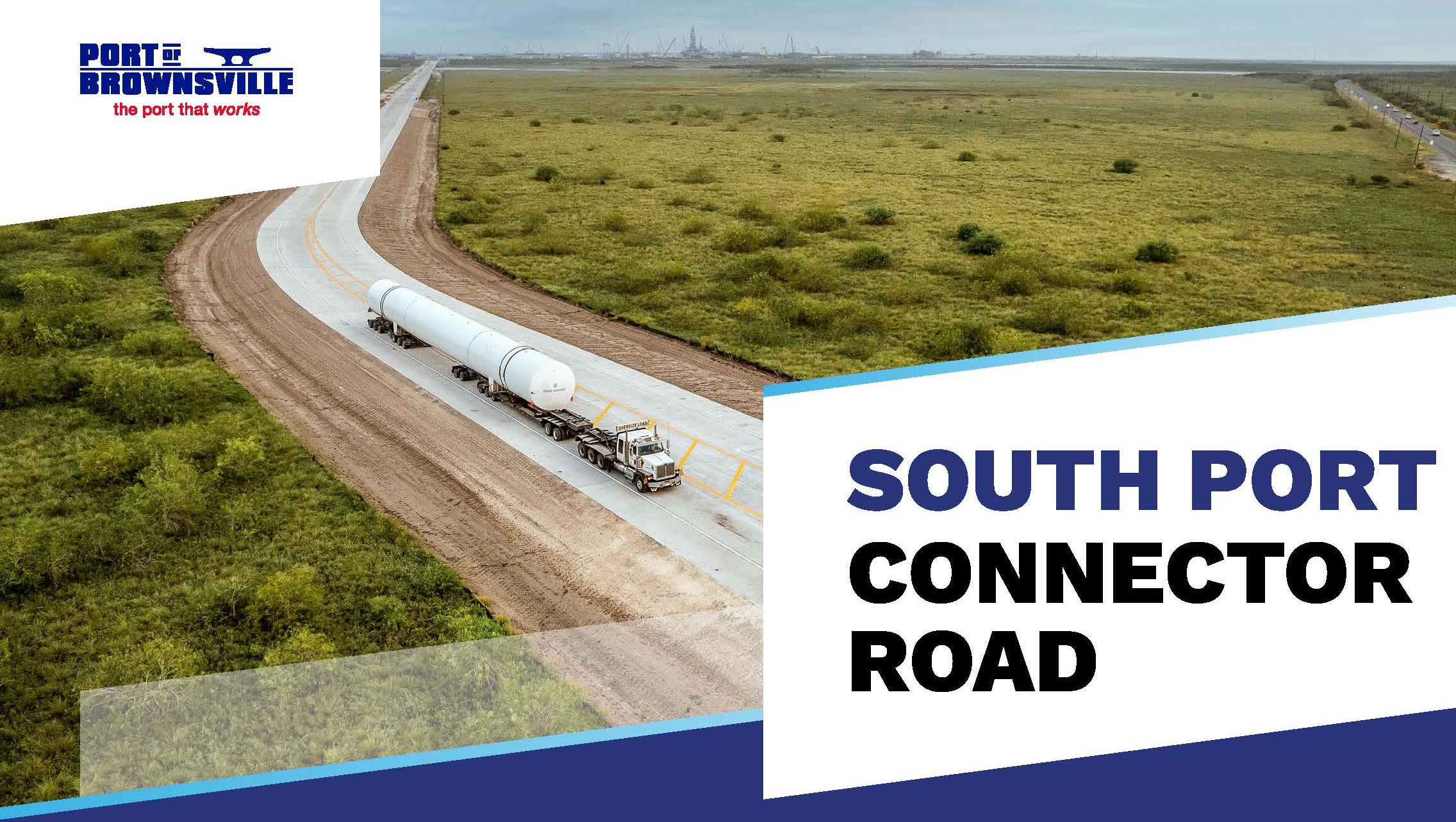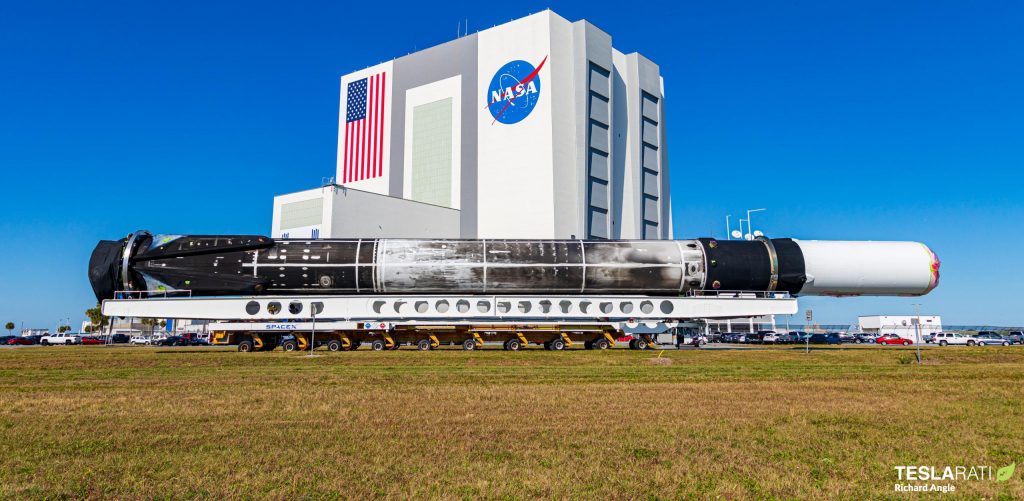

News
SpaceX Starbase facilities already taking advantage of new “Port Connector Road”
SpaceX’s Starbase facilities appear to have immediately begun to take advantage of a brand new “South Port Connector Road” built by the Port of Brownsville.
Construction of the two-mile-long ~$26 million Connector Road began in August 2020 and has long been assumed to be directly related to – or at least catalyzed by – SpaceX’s growing presence in the region. The new road will directly connect the Port of Brownsville to Highway 4, effectively offering SpaceX a direct line of access between Starbase – a South Texas Starship factory and launch site – and the Gulf of Mexico. While it’s difficult to find praise for taking almost two years to construct a more or less straight 1.9-mile-long (~3 km) stretch of road, the Connector should nonetheless offer SpaceX a number of new options.
The simplest and most obvious benefit: ease of transport. The Connector Road should cut off around 5-10 miles of the 15-20-mile drive needed to deliver something from the Port of Brownsville to Starbase (or vice-versa). In theory, the reduction in driving distance doesn’t actually matter much. The real boon comes from the fact that the road could almost entirely negate the need for deliveries to use urban roads.
If SpaceX has the ability to at least temporarily use dock space closest to the Connector Road, future deliveries could feasibly spend just a few hundred feet on city streets. The rest of the journey would be spent on relatively spacious highways. For most shipping, that would be mostly irrelevant, but it’s invaluable for a company like SpaceX that regularly needs (or wants) to transport massive objects by road. Transporting any load that is exceptionally wide, long, or tall can be a relatively painful ordeal, often requiring close coordination with local police or transportation departments to – at the minimum – ensure that it can be done safely, shadow the delivery, and manage traffic.

In extreme cases, the roadway itself might have to be temporarily modified to avoid damage to power lines, cables, street lights, signs, and more. In particularly dense areas, that can dramatically increase the cost of road transport to the point that even extreme alternatives – like building a rocket factory in the middle of nowhere, for example – become alluring.
Seemingly demonstrating its utility, SpaceX appears to have immediately taken advantage of the Port Connector Road almost as soon as it was ready to use. Around February 23rd, days before the road’s ribbon-cutting ceremony and official opening, an official image shared by the Port of Brownsville shows one of five newly installed Starbase propellant tanks heading from the port to Highway 4. While not a particularly challenging payload, the sheer length of the tank would have made any alternative route painful and likely required significant traffic control for any turns. Instead, the Port Connector Road likely made it a straight shot requiring little more than a private escort or two.
The real question is whether the new road will enable the transport of entire Starships or Super Heavy boosters – or even just subsections of the rockets – from Texas to Florida and whether SpaceX will actually choose to do so. Even with the Port Connector Road, some power lines, signs, and lights would likely need to be temporarily removed for SpaceX to transport something as tall and wide as a Starship or Super Heavy, but the breadth of the work required has likely been reduced by at least an order of magnitude. SpaceX has already broken ground on what is expected to become a Florida Starship factory but even partially completing that facility to the point that it can start to build rockets could easily take 6-12 months.
In short, the Port Connector Road’s benefits might be enough for SpaceX to conclude that the one-off transport of a handful of Starships and Super Heavy boosters is worth the lowered cost. That will be especially true if SpaceX is effectively forced to restart Starbase’s environmental review process, in which case Florida – not Texas – could become the preferred location for Starship’s first orbital test flights.

Elon Musk
Elon Musk and Tesla AI Director share insights after empty driver seat Robotaxi rides
The executives’ unoccupied tests hint at the rapid progress of Tesla’s unsupervised Robotaxi efforts.

Tesla CEO Elon Musk and AI Director Ashok Elluswamy celebrated Christmas Eve by sharing personal experiences with Robotaxi vehicles that had no safety monitor or occupant in the driver’s seat. Musk described the system’s “perfect driving” around Austin, while Elluswamy posted video from the back seat, calling it “an amazing experience.”
The executives’ unoccupied tests hint at the rapid progress of Tesla’s unsupervised Robotaxi efforts.
Elon and Ashok’s firsthand Robotaxi insights
Prior to Musk and the Tesla AI Director’s posts, sightings of unmanned Teslas navigating public roads were widely shared on social media. One such vehicle was spotted in Austin, Texas, which Elon Musk acknowleged by stating that “Testing is underway with no occupants in the car.”
Based on his Christmas Eve post, Musk seemed to have tested an unmanned Tesla himself. “A Tesla with no safety monitor in the car and me sitting in the passenger seat took me all around Austin on Sunday with perfect driving,” Musk wrote in his post.
Elluswamy responded with a 2-minute video showing himself in the rear of an unmanned Tesla. The video featured the vehicle’s empty front seats, as well as its smooth handling through real-world traffic. He captioned his video with the words, “It’s an amazing experience!”
Towards Unsupervised operations
During an xAI Hackathon earlier this month, Elon Musk mentioned that Tesla owed be removing Safety Monitors from its Robotaxis in Austin in just three weeks. “Unsupervised is pretty much solved at this point. So there will be Tesla Robotaxis operating in Austin with no one in them. Not even anyone in the passenger seat in about three weeks,” he said. Musk echoed similar estimates at the 2025 Annual Shareholder Meeting and the Q3 2025 earnings call.
Considering the insights that were posted Musk and Elluswamy, it does appear that Tesla is working hard towards operating its Robotaxis with no safety monitors. This is quite impressive considering that the service was launched just earlier this year.
Elon Musk
Starlink passes 9 million active customers just weeks after hitting 8 million
The milestone highlights the accelerating growth of Starlink, which has now been adding over 20,000 new users per day.

SpaceX’s Starlink satellite internet service has continued its rapid global expansion, surpassing 9 million active customers just weeks after crossing the 8 million mark.
The milestone highlights the accelerating growth of Starlink, which has now been adding over 20,000 new users per day.
9 million customers
In a post on X, SpaceX stated that Starlink now serves over 9 million active users across 155 countries, territories, and markets. The company reached 8 million customers in early November, meaning it added roughly 1 million subscribers in under seven weeks, or about 21,275 new users on average per day.
“Starlink is connecting more than 9M active customers with high-speed internet across 155 countries, territories, and many other markets,” Starlink wrote in a post on its official X account. SpaceX President Gwynne Shotwell also celebrated the milestone on X. “A huge thank you to all of our customers and congrats to the Starlink team for such an incredible product,” she wrote.
That growth rate reflects both rising demand for broadband in underserved regions and Starlink’s expanding satellite constellation, which now includes more than 9,000 low-Earth-orbit satellites designed to deliver high-speed, low-latency internet worldwide.
Starlink’s momentum
Starlink’s momentum has been building up. SpaceX reported 4.6 million Starlink customers in December 2024, followed by 7 million by August 2025, and 8 million customers in November. Independent data also suggests Starlink usage is rising sharply, with Cloudflare reporting that global web traffic from Starlink users more than doubled in 2025, as noted in an Insider report.
Starlink’s momentum is increasingly tied to SpaceX’s broader financial outlook. Elon Musk has said the satellite network is “by far” the company’s largest revenue driver, and reports suggest SpaceX may be positioning itself for an initial public offering as soon as next year, with valuations estimated as high as $1.5 trillion. Musk has also suggested in the past that Starlink could have its own IPO in the future.
News
NVIDIA Director of Robotics: Tesla FSD v14 is the first AI to pass the “Physical Turing Test”
After testing FSD v14, Fan stated that his experience with FSD felt magical at first, but it soon started to feel like a routine.

NVIDIA Director of Robotics Jim Fan has praised Tesla’s Full Self-Driving (Supervised) v14 as the first AI to pass what he described as a “Physical Turing Test.”
After testing FSD v14, Fan stated that his experience with FSD felt magical at first, but it soon started to feel like a routine. And just like smartphones today, removing it now would “actively hurt.”
Jim Fan’s hands-on FSD v14 impressions
Fan, a leading researcher in embodied AI who is currently solving Physical AI at NVIDIA and spearheading the company’s Project GR00T initiative, noted that he actually was late to the Tesla game. He was, however, one of the first to try out FSD v14.
“I was very late to own a Tesla but among the earliest to try out FSD v14. It’s perhaps the first time I experience an AI that passes the Physical Turing Test: after a long day at work, you press a button, lay back, and couldn’t tell if a neural net or a human drove you home,” Fan wrote in a post on X.
Fan added: “Despite knowing exactly how robot learning works, I still find it magical watching the steering wheel turn by itself. First it feels surreal, next it becomes routine. Then, like the smartphone, taking it away actively hurts. This is how humanity gets rewired and glued to god-like technologies.”
The Physical Turing Test
The original Turing Test was conceived by Alan Turing in 1950, and it was aimed at determining if a machine could exhibit behavior that is equivalent to or indistinguishable from a human. By focusing on text-based conversations, the original Turing Test set a high bar for natural language processing and machine learning.
This test has been passed by today’s large language models. However, the capability to converse in a humanlike manner is a completely different challenge from performing real-world problem-solving or physical interactions. Thus, Fan introduced the Physical Turing Test, which challenges AI systems to demonstrate intelligence through physical actions.
Based on Fan’s comments, Tesla has demonstrated these intelligent physical actions with FSD v14. Elon Musk agreed with the NVIDIA executive, stating in a post on X that with FSD v14, “you can sense the sentience maturing.” Musk also praised Tesla AI, calling it the best “real-world AI” today.








